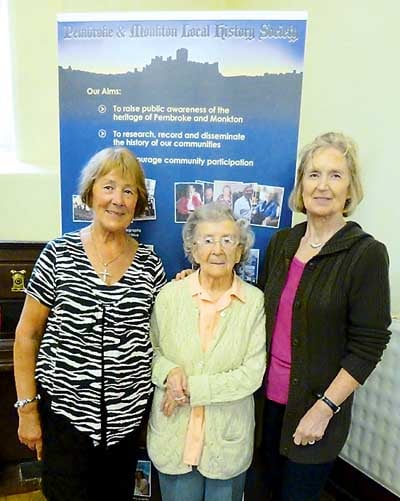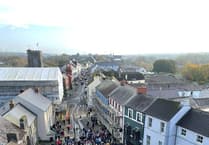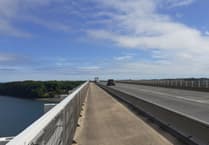Return to Portsmouth
Last week, I wrote about my visit to the Warrior in Portsmouth. I had another reason for visiting old Pompey - I lived there many years ago, moving there when I was about eight. This takes me back to the far distant years of the 1950s! The place where I lived, Copnor, hadn't changed much - streets of pre-war terraced houses, the school I went to still there was mixed not girls only... although the city itself now has a smart shopping centre and new quayside developments. But how my mother hated Portsmouth - we only stayed two years and back to lovely Pembrokeshire!
The Portsmouth Connection
I have memories of outings with the Pembrokeshire Society whilst living in Portsmouth. Portsmouth of course has a strong link with Pembroke and Pembroke Dock and these dates back to the closure of the dockyard in 1926.
This had a huge impact on both towns. At the time, a petition was sent to Prime Minister Stanley Baldwin stressing the lack of alternative employment and the economic consequences to the area, but the decision was irreversible. The Navy simply had too many dockyards and the Admiralty had to keep a fleet together with much-reduced funds. The First Sea Lord, Admiral of the Fleet Earl Beatty, in his speech at The Lord Mayor's Banquet on November 9, 1925, stressed the government's position:
"Whether these Yards are necessary for naval purposes, the Admiralty is the only competent judge. As to whether they are necessary for political or social reasons is for the Government to decide. The fact is, that so far as the upkeep of the Fleet is concerned, they are entirely redundant."
And so the dockyard, which gave Pembroke Dock its name and provided employment for so many in both towns, closed down in 1926. Over the span of 106 years, five royal yachts had been built there, along with 263 other Royal Navy vessels. The last ship launched from the dockyard was the Royal Fleet Auxiliary tanker Oleander on April 26, 1922. In its Victorian heyday, it was a world leader in shipbuilding: the chief constructor of the American Navy, Philip Hitchborn USN, who visited all the European dockyards in 1885 is reported to have said: "Pembroke Royal Dockyard is the first shipbuilding yard in the world and best adapted for building operations."
A devastating effect
The effect was devastating on both Pembroke and Pembroke Dock. Being the major employer, great hardship was experience by many: those not employed in the dockyard lost their jobs in the resultant depression. It led to an exodus of men to other dockyards in search of work, principally to Devonport, Chatham and Portsmouth.
One of these was the father of late Connie Brown MBE -she however could not settle in Portsmouth and returned to Pembroke.
"I missed my boyfriend, Sid Brown," she told me.
They married and we all know how that story ended!
David James, of the West Wales Maritime Heritage Society, told me that some travelled as far away as Gibraltar and Malta.
"Some of my ancestors were writers and underwriters in the dockyard and went to Gibraltar. My father went to London where he remained until the Blitz in 1940 caused him to return to Pembroke Dock with his family."
Jean's Story
A valuable contributor to our community history is Jean Williams. The dockyard and its closure greatly affected her early years. As was the case with so many local families, her forebears originally settled here drawn to the Dockyard and its huge demand for labour.
"My family had a long association with Pembroke Dockyard. Family tradition has it that my great grandparents, William and Jane Ferguson came from Dunfermline, Scotland on the Great Eastern to Neyland and he obtained work in the Dockyard where he worked as a wheelwright.
"Both my grandfathers and my father were craftsmen there. Like most families, ours was dependent on the dockyard for work so when it closed in 1926 the effect was catastrophic.
"Some tradesmen were relocated to other dockyards and my paternal grandfather went to Devonport. My father, who was newly married, stayed in Pembroke where I spent my early years and was educated in the East End School. However, in the early 1930s, he, along with three friends, also left for Portsmouth. My mother and I followed later that year.
"I have memories of living in Copnor and of the Royal Dockyard where we had Christmas parties and of spending many Saturday mornings visiting various places watching my father playing cricket. I have a photograph here of him playing in the Portsmouth Dockyard Torpedo Depot Section team - I still have the cup won when they were runners up in the Portsmouth District Cricket League. He was always a keen cricketer as was my grandfather. Before we left for Portsmouth, I would go up to the Shoulder of Mutton field just across the road from our home in Paradise Row and watch him playing cricket."
Tragically, Bill Williams died in August 1937 at the young age of 36. At the end of that year, Jean and her mother returned to the family home in Pembroke at Little Bangeston and Jean never again left Pembroke.
A long career in the Pembroke Borough Council following the war, she worked in the housing department.
"Because of the large numbers of applicants and tenants I dealt with over the years my face became all too familiar in the town!"
November events
Tomorrow (Saturday, November 3), we have our monthly coffee morning and exhibition from 10.30 - 1. I shall be giving a presentation about our Heritage Lottery supported project: 'Through My Eyes - a Community History of Pembroke and Monkton.' All are welcome and entry is free.
Friday, November 16: talk by David James 'Pembrokeshire People' - some of the great and famous who have visited here. Also at Monkton Priory Church Hall at 7.30 pm. Entry is free and open to all.
Contact
If you have any stories or photographs for this column, please contact me, Linda Asman, on 01646 622428, email [email protected]">[email protected] and visit our website http://www.pembrokeandmonkonhistory.org.uk">www.pembrokeandmonkonhistory.org.uk.





Comments
This article has no comments yet. Be the first to leave a comment.